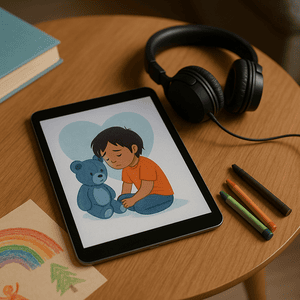Online Resources for Grieving Kids

Types of Funeral Services: Religious Funeral Services
June 1, 2025
Group Therapy for Grieving Children
July 12, 2025More than 5.6 million children in the U.S. will experience the death of a parent or sibling by age 18, according to the Childhood Bereavement Estimation Model (CBEM). That number is rising, and so is the need for meaningful grief support tailored to kids.
While in-person counseling remains essential, many families now turn to online grief resources for children to supplement or replace traditional support. Whether due to limited access to local services, long waitlists, or a child’s comfort level, digital grief tools have become a lifeline. They offer flexibility, privacy, and gentle guidance when and where a child needs it most.
This article curates a wide range of trusted online grief resources, from interactive apps and videos to virtual support groups and educational websites. Each tool includes clear details on age range, format, and how it helps children navigate grief with care. Whether you’re a parent, teacher, or counselor, you’ll find accessible options to meet a child exactly where they are, and support them as they heal.
Why Online Grief Resources Matter for Children
Grief is never one-size-fits-all, especially for children. The way they process loss can shift daily, and their comfort with expressing it varies widely. That’s where online grief resources come in, they offer flexible, age-appropriate support that fits into a child’s life without overwhelming them. Digital tools can meet children on their own terms, whether they prefer quiet reflection, playful engagement, or visual storytelling.
Accessibility and Privacy
One of the biggest strengths of online grief tools is the ability to access them anytime, from anywhere. A child who finds it difficult to speak openly in a group setting can explore an interactive app or watch a comforting video at their own pace. This kind of privacy matters. For many kids, especially those who are introverted, anxious, or unsure how to talk about their feelings, digital spaces create safety.
Online resources also help bridge gaps for families in rural areas or communities where in-person grief programs are limited. Instead of waiting for availability, families can find immediate support that’s free or low-cost, often designed by experts who understand how children grieve.
Reinforcing Support Between Counseling Sessions
Therapy sessions offer crucial guidance, but they aren’t daily touchpoints. Digital grief resources can gently fill the in-between spaces. A child might use a journaling app before bedtime or watch a short animation that helps explain death in simple language. Some apps even prompt check-ins or reflection exercises that encourage emotional awareness without pressure.
Used thoughtfully, online tools don’t replace therapy, they strengthen it. They help children carry the progress made in sessions into their day-to-day routines, keeping the process active and personal.
Supporting Parents and Caregivers Too
Digital grief resources often include more than just child-facing content. Many are designed to help adults navigate those first, hard conversations with children. Whether it’s a printable storybook, a caregiver’s guide, or a short explainer video, these resources offer parents simple language, conversation starters, and reassurance.
When adults feel more prepared, they’re better able to offer the steady support kids need. And when parents use the tools alongside their children, they reinforce connection, understanding, and emotional safety.
The value of online resources isn’t just in the content, it’s in the comfort they provide to children and the confidence they give to the adults who love them. Next, we’ll explore the most trusted grief support websites that offer these benefits in action.
Best Grief Apps and Interactive Tools for Kids
When it comes to helping children process grief, interactivity can be just as powerful as conversation. Many kids respond more openly to apps than to adult-led discussions, especially when those apps are designed with compassion and clinical insight. Below are some of the most effective grief-focused apps and interactive tools available today—each chosen for its thoughtful design, age-appropriate content, and emotional safety.
Apart of Me
Platform: iOS and Android
Age Range: 7–16
Apart of Me offers an immersive, game-like world where children explore grief through calming visuals, quests, and gentle storytelling. Developed by therapists, the app uses a peaceful island environment to guide users through real stories, reflective prompts, and mindfulness practices. It’s particularly useful for kids who are hesitant to open up verbally but are drawn to interactive environments where they can explore feelings on their own terms.
Smiling Mind
Platform: iOS and Android
Age Range: 5–18
Though not specific to grief, Smiling Mind is widely used by school counselors and families to help children manage emotions. The app includes guided meditations, breathing exercises, and emotion-regulation tracks tailored by age group. For grieving children, it supports emotional grounding, especially during moments of anxiety or sadness. It’s a helpful daily tool to keep emotions from feeling overwhelming.
Grief: Support for Young People
Platform: Web-based (via Winston’s Wish – UK-based)
Age Range: 12–18
This browser-based tool offers interactive activities, reflective journaling prompts, and straight-talk guidance designed specifically for teenagers. Teens can explore how grief shows up in friendships, school, and everyday life—without judgment or oversimplification. It’s ideal for older children who want space to think through loss in their own voice, with the flexibility of choosing when and how they engage.

My Grief Angels App
Platform: iOS and Android
Age Range: All ages (with parental guidance)
My Grief Angels includes video stories, community insights, and peer-based resources designed to help children and families feel less alone. The app offers access to grief support directories, journaling spaces, and curated articles. While not solely child-focused, the app is a valuable shared tool for parents and kids navigating grief together—especially for those seeking both peer and practical support in one place.
These apps give grieving children gentle structure, creative outlets, and access to meaningful support—without pressure. Up next, we’ll explore where families can find live, virtual grief counseling and support groups for deeper, real-time connection.
Virtual Grief Counseling and Support Groups
Some children need more than self-guided activities or apps—they need connection. Whether with a licensed therapist, trained facilitator, or peers who’ve experienced loss, real-time interaction can create a safe space for grieving kids to feel understood. The options below offer structure, empathy, and human presence—all from home.
Online Therapy Platforms
Several online therapy services now offer sessions specifically tailored for children and teens. Platforms like TeenCounseling connect families with licensed professionals who specialize in grief, trauma, and childhood emotional development. Sessions are conducted via video, phone, or live chat, allowing kids to speak in whatever format feels most natural to them.
Parents or legal guardians must set up the account and approve participation for minors. Most platforms conduct an intake questionnaire to match children with appropriate therapists based on age, emotional needs, and availability. These services can be especially helpful for kids who aren’t ready for group programs or who need more personalized, clinical support.
Grief Camps and Virtual Retreats
Grief camps have long played an important role in helping kids build emotional resilience. Many of the most trusted programs now offer virtual retreats for children who can’t attend in person. These sessions combine therapeutic group activities with games, music, and creative expression—all led by trained staff and volunteers.
Comfort Zone Camp and Camp Erin both offer virtual weekends several times a year. Participation is free, though families must complete an application and intake process beforehand. Activities are age-specific and structured to help children connect with peers, share stories, and express emotions in safe, moderated ways.
These group experiences remind grieving kids they’re not alone, and that others their age are walking a similar path.
As we move to the next section, we’ll look at how caregivers can choose the right type of grief resource for their child by considering learning styles, emotional readiness, and the right blend of digital and real-world support.
How to Choose the Right Online Grief Resource for Your Child
Not every digital grief resource will suit every child, and that’s okay. Choosing the right one means knowing what your child responds to, what comforts them, and how much structure they need. Below are a few simple ways to narrow down your options and choose a resource that actually supports their healing, rather than overwhelms it.
Consider Age and Learning Style
Younger children often need play-based or visual tools. Look for apps with interactive features, colorful characters, or guided stories. They’re more likely to engage with platforms like Sesame Street in Communities or Apart of Me, spaces designed for imaginative exploration and emotional safety.
Older kids and teens might prefer self-paced content. Journaling prompts, podcasts, or peer support forums like KidsAid often appeal more to kids who want privacy but still need a trusted outlet. Some may find calm in structured mindfulness tools; others need something that feels less therapeutic and more like a game.
Be Involved and Monitor Use
Always preview digital resources before introducing them. Sit with your child during their first use and observe how they respond. If they seem withdrawn, anxious, or disinterested, it might not be the right fit. Ask open-ended questions afterward, what part stood out, what made them feel seen, or if anything was confusing.
Also, remember that grief can change daily. What helps one week might feel like too much the next. Check in regularly without pressure. They don’t always need to talk about the loss, they just need to know you’re paying attention.
Combine With Offline Rituals or Conversations
Digital support should never replace the real-world rituals that help children feel safe and grounded. Pairing a grief app or journaling tool with a physical keepsake, like a memory box or personalized prayer card, gives them a tangible way to express love and connection.
Try lighting a candle during a bedtime meditation, or set aside quiet time after school to draw or write together. These gentle rituals create space for kids to process emotions without forcing conversation. They also show that grief is something shared, not something they have to navigate alone.
Conclusion
Grief doesn’t follow a straight path, especially for children. While digital grief support can’t replace presence and love, it can offer a steady hand when emotions feel unpredictable. Tools like story-based apps, virtual support groups, and guided journaling platforms give kids safe, age-appropriate ways to process loss, on their terms and at their own pace.
The key is combining the digital with the deeply personal. A prayer card with a sibling’s artwork. A memory bookmark beside a grief app. A bedtime conversation after a mindfulness session. These small, layered acts create emotional structure, and remind children that their grief matters and their loved one is not forgotten.
Start with one trusted tool. See how your child responds. Then build slowly from there. With time, attention, and both virtual and tangible support, healing becomes not only possible, but personal.


